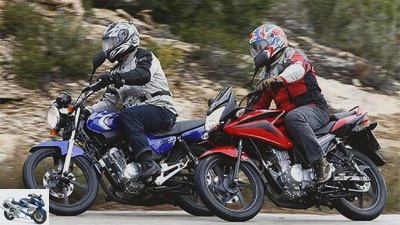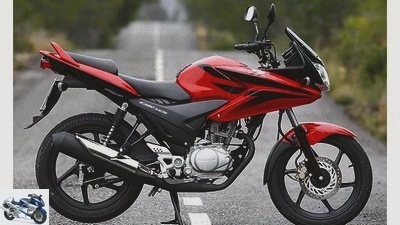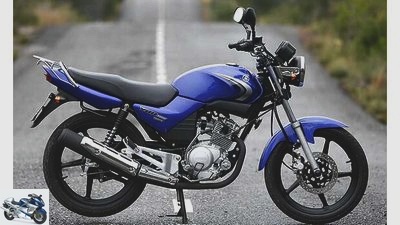Table of contents
- Comparison test Honda CBF 125 against Yamaha YBR 125 Inexpensive 125cc singles
- Curving pleasure with 125s
- Technical data Honda CBF 125
- Technical data Yamaha YBR 125
- That’s what the youngsters say

fact
motorcycles
Comparison test Honda CBF 125 against Yamaha YBR 125
Comparison test Honda CBF 125 against Yamaha YBR 125
Inexpensive 125cc singles
No frills, economical motorcycles at a reasonable price, so far the offer has been rare. What else can the little four-stroke engine do? except cheap?
Werner Koch
29/01/2009
Yes, yes, today’s youth. It is always said that she is tired of surfing the electronic universe rather than the real world on a motorcycle. But maybe the hobby had simply become too expensive. That could change immediately, because Honda is releasing the CBF 125 for 2100 euros? with fairing and sleek design. For 250 euros more, the Yamaha dealer also pushes a new YBR 125 in front of the shop door? without fairing, but with a practical luggage rack. Visually two worlds, technically a league. Clearly arranged instruments, with the Yamaha even with a rev counter, impeccable switch units and rear-view mirrors that deserve their name. Simple, air-cooled four-stroke engines with two valves but electronic injection get the lightweights on their toes.
Injection technology and catalysts
The catalytic converters are located in the black painted exhaust pipes, on the Honda even a regulated one that works even more efficiently than on the Yamaha thanks to the lambda probe on the exhaust duct. The lambda probe measures the oxygen content in the exhaust gas in fractions of a second and forwards the data to the electronic injection system, which then injects the optimum amount of gasoline into the intake air. The result: fewer pollutants and lower consumption.
With a weight of 131 and 125 kilograms, nothing stands in the way of lively maneuverability. Especially since the seat height of 790 and 780 millimeters for the Yamaha also relieves insecure boys and girls of panic when turning and maneuvering. The steering angle large enough, the clutches finely adjustable and the engines with instantaneous throttle response, so you can stalk stress-free through the hustle and bustle of traffic. If it’s going overland, you should keep both 125s happy with hardworking gearshifts and high revs. The Honda engine is a bit more powerful when it comes to pulling through, but the handlebars and notches are set in motion by fine vibrations. A nominal eleven hp for the Honda and ten for the Yamaha are enough for a serious 100 km / h, the rider in a hurry can also manage tachometer 110 when bent over. Behind the Honda fairing, it even stays reasonably dry in rainy weather, while the Yamaha rider is relentlessly exposed to the elements.
Curving pleasure with 125s

fact
Even if you don’t look at it right away: the Honda CBF 125 and Yamaha YBR 125 put you in a good mood when chasing curves.
If you want to enhance the factual movement with a dash of fun dynamism, please. Because on knotted, narrow country roads there is real joy, because the old game of jagged inclines and finely curled curve lines can also be played amusingly with the two 125s. Decent engine torque, sufficiently powerful brakes, a good-natured chassis as well as the upright, relaxed seating position allow even bloody novice drivers to move quickly. Whereby the technically simpler single-piston brake of the YBR grips more powerfully with good controllability than the double-piston caliper of the CBF and the Yamaha chassis, even on undulating roads and in steep downhill bends, conveys a confident, safe driving experience.
On the Honda, on the other hand, the driver hangs over the handlebars in a much more front-wheel-oriented manner, struggling with a restless, indifferent front section when leaning, which requires more concentration and fine steering corrections in the search for a clean line. Attempts with higher tire pressure did not bring any improvement, nothing can be adjusted on the fork. So it remains that the Yamaha is superior to the Honda at the cornering break, possibly also because of the 18-inch wheels compared to the 17-inchers of the CBF.
In return, the five gears of the CBF engine click themselves into place precisely and smoothly when things get down to business, while the Yamaha transmission with the not quite optimally placed gear lever is more of the gnarled variety. Both machines roll on “no-name” tires. TVS tires at the CBR, Cheng Shin rubbers encircle the Yamaha cast wheels. But if you think that tire engineers from the Far East only know the concept of wet grip from the technical dictionary, you are wrong. On the Spanish mountain roads, both tires clawed their way into the still damp asphalt with astonishing grip and good feedback. No mercy for the small four-stroke engines on the mountain and valley tour: the gas tap is permanently on and the speed is at the limit, the Yamaha engine consumes 3.3 liters per 100 kilometers. The lambda-regulated Honda single-cylinder approved a good 2.7 liters. Which means that the CBF 125 is hard to beat in terms of economy, in addition to the low purchase price.
Technical data Honda CBF 125

fact
engine
Air-cooled single-cylinder four-stroke engine, an overhead, chain-driven camshaft, two valves, rocker arm, wet sump lubrication, injection, Ø 26 mm, regulated catalytic converter, 170 W alternator, 12 V battery /
6 Ah, mechanically operated multi-disc oil bath clutch, five-speed gearbox, chain, secondary ratio 42:16.
Bore x stroke 52.4 x 57.8 mm
Cubic capacity 125 cm³
Compression ratio 9.2: 1
Rated output 8.3 kW (11 hp) at 8000 rpm
Max. Torque 11 Nm at 6250 rpm
landing gear
Central tubular frame made of steel, telescopic fork, Ø 30 mm, two-arm swing arm made of steel, two spring struts, adjustable spring base, front disc brake, Ø 240 mm, double-piston floating caliper, rear drum brake, Ø 130 mm.
Cast aluminum wheels 1.85 x 17; 2.15 x 17
Tires 80 / 10-17; 100 / 90-17
Tires in the TVS test
Dimensions + weights
Wheelbase 1270 mm, steering head angle 64.5 degrees, caster 89 mm, spring travel f / r 115/87 mm, seat height * 790 mm, weight with a full tank * 131 kg, payload * 177 kg, tank capacity 13.0 liters.
Warranty two years
Service intervals every 4000 km
Colors red, black, silver
Price 2100 euros
Additional costs around 170 euros
Technical data Yamaha YBR 125

fact
engine
Air-cooled single-cylinder four-stroke engine, an overhead, chain-driven camshaft, two valves, rocker arms, wet sump lubrication, injection, Ø 26 mm, uncontrolled catalytic converter, 115 W alternator, 12 V / 6 Ah battery, mechanically operated multi-plate oil bath clutch, five-speed gearbox, chain, secondary transmission 34:14.
Bore x stroke 54.0 x 54.0 mm
Cubic capacity 124 cm³
Compression ratio 10: 1
Rated output 7.5 kW (10 PS) at 7800 rpm
Max. Torque 10 Nm at 6000 rpm
landing gear
Single-loop frame made of steel, telescopic fork, Ø 30 mm, two-arm swing arm made of steel, two spring struts, front disc brake, Ø 245 mm, single-piston floating caliper, rear drum brake, Ø 130 mm.
Cast aluminum wheels 1.85 x 18, 2.15 x 18
Tires 2.75-18; 90 / 90-18
Tires in the Cheng Shin test
Dimensions + weights
Wheelbase 1290 mm, steering head angle 63.7 degrees, caster 90 mm, spring travel f / r 120/105 mm, seat height * 780 mm, weight with a full tank * 125 kg, tank capacity 15.0 liters.
Warranty two years
Service intervals every 6000 km
Colors gray, red, black, blue
Price 2350 euros
Additional costs around 150 euros
That’s what the youngsters say
?? Anyone who drives a motorcycle at the age of 16 or 17 will only be accepted if the moped and the rest are correct. So not a jet helmet, but a full-face helmet with a cool design or in black. The same applies to motorcycles. The Yamaha is too staid, too puny. You can see immediately that it is a 125cc. Therefore prefer the Honda, the fairing of which conceals the 125cc quite well. Driving is good for both of you.
Christof Koch, 18
Related articles
-
Gargolov motorcycles Comparison test: big bikes Comparison test: Big Bikes from Honda and Suzuki Test: Honda CBF 1000 F, CB 1300 S and Suzuki Bandit 1250…
-
Honda CBF 600 S, Suzuki Bandit 650 S, Yamaha FZ6 Fazer
Rossen Gargolov 17th pictures Suzuki 1/17 Suzuki 2/17 Suzuki 3/17 Suzuki 4/17 Suzuki 5/17 Suzuki 6/17 Suzuki 7/17 Suzuki 8/17 Suzuki 9/17 Suzuki 10/17…
-
Artist 48 pictures Artist 1/48 Four inexpensive motorcycles have appeared in the south of France … Artist 2/48 Artist 3/48 The winner of the 1000-point…
-
fact motorcycles Comparison test: Honda CBR 600 RR, Kawasaki ZX-6R, Suzuki GSX-R 600, Triumph Daytona 675, Yamaha YZF-R6 Comparison test: Honda CBR 600…
-
Comparison test: Honda CBF 600 S and Kawasaki ER-6f
Gargolov motorcycles Comparison test: Honda CBF 600 S and Kawasaki ER-6f Comparison test Honda CBF 600 S and Kawasaki ER-6f They don’t shine in the…
-
Endurance test final balance: Yamaha YZF-R 125
jkuenstle.de motorcycles Endurance test final balance: Yamaha YZF-R 125 Endurance test final balance: Yamaha YZF-R 125 The Yamaha YZF-R 125 after its…
-
markus-jahn.com 28 pictures markus-jahn.com 1/28 Honda Crossrunner. markus-jahn.com 2/28 The basic construction of the Crossrunner comes from the time…
-
Comparison test of 125 cc athletes
Artist motorcycles Comparison test of 125 cc athletes Comparison test 125 cc sports car, Aprilia RS 125, Cagiva Mito 125, Derbi GPR 125 Racing 4T 4V,…
-
fact motorcycles Middle class comparison test Middle class comparison test Just turn blue The sun is shining, the early autumn beckons: away with pencil…
-
Comparison test Honda CBF 1000 and Honda CBF 1000 F
Jahn 10 pictures Rudolph 1/10 Even when the going is steep uphill, the CBF 1000 F pulls on without ceasing. Rudolph 2/10 Now adjustable: the spring…